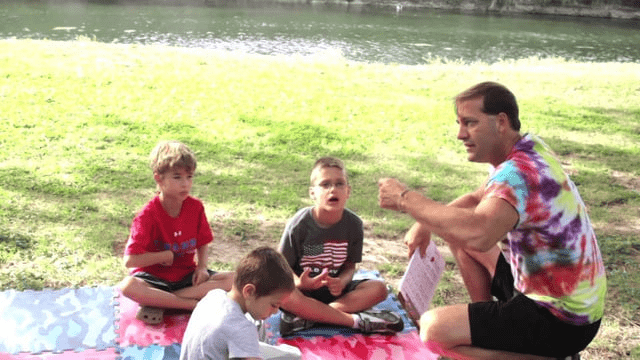Counseling IEP Goals Menu

Related Service Counseling and Counseling IEP Goals Menu
(scroll down the page for the related service counseling IEP goals menu)
Update: Telemedicine virtual online counseling now available here: https://www.bradmasoncounselor.com/
Coronavirus Kid Care Kit detailing how to reassure kids in crisis by age group, structuring their day, menu of offline at-home activities, and managing technology use. Children with special needs and behavior problems stuck at home without structure can push their parents to the edge. Send them this free resource.
Counseling Services
IDEA defines related service counseling as follows:
(2) Counseling services means services provided by qualified social workers, psychologists, guidance counselors, or other qualified personnel. [§300.34(c)(2)]
According to the American School Counselor Association (2007), counseling services are intended to help all children in the areas of academic achievement, personal/social development and career development. This can include helping children with personal and social concerns such as developing self-knowledge, making effective decisions, learning health choices, and improving responsibility. Counselors may also help children with future planning related to setting and reaching academic goals, developing a positive attitude toward learning, and recognizing and utilizing academic strengths.
Note that IDEA’s list of related services includes other counseling services—parent counseling and training; and rehabilitation counseling (that is, counseling specific to career development and employment preparation). These are defined separately in IDEA and are clearly different from counseling services (which are also not to be confused with psychological services).
§300.34 Related services.
(a) General. Related services means transportation and such developmental, corrective, and other supportive services as are required to assist a child with a disability to benefit from special education, and includes….
This beginning represents the core of how IDEA defines related services. The term related services is typically spoken in the same breath as special education (similar to how “peas and carrots” and “ham and eggs” go together) and, when used in IDEA, will always have the same meaning, including the part of the definition we haven’t shown you yet, which picks up where the beginning leaves off…
…and includes speech-language pathology and audiology services, interpreting services, psychological services, physical and occupational therapy, recreation, including therapeutic recreation, early identification and assessment of disabilities in children, counseling services, including rehabilitation counseling, orientation and mobility services, and medical services for diagnostic or evaluation purposes. Related services also include school health services and school nurse services, social work services in schools, and parent counseling and training.
Clearly, the list of related services is extensive–and, as already mentioned, the list is not exhaustive. These are just the services that IDEA specifically mentions. As states respond to the requirements of federal law,
– See more at: http://www.wrightslaw.com/info/relsvcs.faqs.htm#sthash.GpWU1BUV.dpuf
Parent Counseling and Training
Parent counseling and training is an important related service that can help parents enhance the vital role they play in the lives of their children. Its definition is found at §300.34(c)(8) and reads:
(8)(i) Parent counseling and training means assisting parents in understanding the special needs of their child;
(ii) Providing parents with information about child development; and
(iii) Helping parents to acquire the necessary skills that will allow them to support the implementation of their child’s IEP or IFSP.
The first two parts of this definition are longstanding in IDEA. The last part—regarding helping parents acquire the necessary skills that will allow them to support the implementation of their child’s IEP or IFSP—was added in IDEA ’97 “to recognize the more active role of parents as participants in the education of their children” (71 Fed. Reg. at 46573) and is retained in IDEA 2004. As with all related services, parent counseling and training would only be provided to parents “if a child’s IEP team determines that it is necessary for the child to receive FAPE” (Id.).
IEP Behavioral and Counseling IEP Goals Menu
Aggression
_________ will demonstrate being mad the right way ___% of observed trials.
_________ will use appropriate strategies to calm themselves with prompts ___% of observed trials.
_________ will allow themselves to be mad or frustrated without hurting 90% of observed opportunities.
_________ will refrain from physical aggression (i.e. kicking, hitting, pushing, tripping) across all environments in school, for 4 consecutive weeks, with all adults and children as measured by event data.
_________ will refrain from aggression (i.e. hitting, kicking, pushing) 100% of the day, across all environments, with all adults and children as measured by special education event data, over 8 consecutive weeks.
Class Participation
_______ will demonstrate raising her hand to participate in whole class and/or small group instruction, 80% of the time in 5 out of 5 intervals, as measured by teacher observations.
_______ will respond when called upon 80% of observed trials.
Coping Skills/ Emotional Regulation/ Self-Regulation
In the classroom environment, ______ will utilize positive self-talk and coping strategies to handle stressful situations or work demands in which he/she manifests anxious or withdrawn behavior (i.e. putting head down, saying he/she can’t do something), demonstrated by engaging in the 30 minute activity or situation in a calm and positive manner with one prompt on 2/3 occasions.
In counseling sessions, _______ will accurately identify feelings and appropriate coping strategies when presented with real or imagined situations with 80% accuracy on 4 out of 5 trials.
When _____ becomes upset, frustrated, or angry, he will use a self-regulation/coping strategy (movement break, deep breathing, quiet space break, deep pressure/heavy work activity, etc.) to avoid engaging in an unexpected behavior, with one reminder, on 4 out of 5 opportunities, as measured by observations and documentation.
__________ will improve his self-regulation skills as demonstrated through utilizing a tool (e.g. inner coach, sensory support, calming break) to aid in regulating to an expected emotional state (e.g. green zone – which is when we feel calm, happy, content, and focused) with one adult reminder on 8 out of 10 instances in a small group setting, as measured over two week period
______ will improve insight on regulation as demonstrated by identifying the instances where he/she could have benefited from utilizing a tool to aid in regulation and determine what tool would have been beneficial for each instance with 80% accuracy.
When presented with a problem (non-preferred task, frustrating situation, criticism/correction), ______ will accurately determine the size of the problem (big problem, little problem) and determine the appropriate emotional response (take a break, talk with teacher, take a deep breath, replace frustration with good thoughts, etc.) and return to task at hand in 4 out of 5 trials as measured by teacher charted data.
When given a frustrating situation (i.e. undesired task, demand, and/or undesired peer behavior), with one prompt ________ will utilize coping strategies (i.e. take a break, deep breaths, etc.) and return to and remain on task with a calm body and mind for a minimum of 10 minutes with an average of 95% over 8 consecutive school weeks, across all classroom environments.
When presented with a situation known by ______ to be anxiety or frustration producing for him (i.e. non-prefered task, unexpected obstacle such as ______, tasks perceived as too difficult, unfamiliar adult, and non-preferred adult), he will independently demonstrate an appropriate emotional response through finding a solution to his problem or using a strategy to regulate back to an expected emotional state (take a break, talk with teacher, etc.) and return to task at hand within 2 minutes, for an average of 80% of instances both throughout all environments and within each environment.
Self-Monitoring
_______ will demonstrate the ability to recognize expected and unexpected behaviors as well as rate his own behavior as part of his self-monitoring system with 80% accuracy as compared to teacher ratings of behavior.
______ will demonstrate the ability to accurately recognize her level of anxiety through the use of a visual self-rating system (e.g. feelings thermometer) with 80% accuracy, as compared to teacher observations and data.
Self -Control
_______ will show self-control of his/her body and voice (good personal space, keeping hands/arms/legs near body, and appropriate voice level) in relation to the expected levels of the classroom and peers around him for 80% of a 20 minute period.
________ will demonstrate self-control in the classroom through raising his/her hand and waiting to be called on by the teacher when he/she has a question in class, with 80% accuracy in 5 out of 5 trials, as measured by teacher observation and data collection.
IEP Goals for Anxiety
(blue underlined text indicates clickable downloadable documents for you to use in counseling sessions)
In counseling sessions, _____ will accurately identify situations that can be anxiety producing and appropriate coping strategies or relaxation techniques when presented with real or imagined situations with 80% accuracy on 4 out of 5 trials.
______ will demonstrate the ability to accurately recognize her level of anxiety through the use of a visual self-rating system (e.g. Stressometer, 1-5 scale) with 80% accuracy, as compared to teacher observations and data.
During counseling sessions, __________ will use menus and highlight their Stress Triggers, personal Stress signs, and Stress Management Strategies that they believe they could utilize successfully.
In counseling sessions for anxiety, __________ will demonstrate understanding of the cognitive-behavioral model by completing and reviewing the Rational vs Irrational Thoughts Practice excercise, Thinking Errors, Thinking Errors Practice, and Thought Record for specific anxious episodes with 80% accuracy.
________ will transition when prompted by teachers 80% of trials by interacting with their visual Activity Schedules.
On-Task/ Work Completion
When given a task or direction ______ will begin the task within 1 minute and remain on task for a minimum of 10 minutes independently with no more than 2 prompts on 8 out of 10 independent tasks, as measured by staff data.
Given a maximum of one verbal cue, _______ will attend to a non-preferred, small-group activity and/or independent assignment, without protest, and remain on task with no task avoidance (bathroom, getting a jacket, tying shoes, sharpening pencil, etc.) for 20 minutes, in 3 out of 4 trials, as measured by observations and staff documentation.
_______ will demonstrate on task-behavior in the general education setting for 75% of intervals during a 10 minute period, with the use of an appropriate fidget and one adult reminder, in 4/5 trials, as measured by observation and data.
________ will attend (sit still, eyes on teacher, hands to self, quiet voice) to a task during large and small group instruction across settings for a 10 minute period with no more then 1 teacher prompt in 4 out of 5 trials as measured by teacher charted data.
With movement breaks and the use of self-regulation strategies, _____ will demonstrate the ability to attend to a task for an average 75% of intervals in a 20 minute class period.
With the use of taught self-regulation strategies and self-monitoring checklists, ______ will independently begin a task (including non-preferred tasks) within 2 minutes of direction for an average of 80% of opportunities, across environments.
With the use of taught self-regulation strategies and self-monitoring checklists, once ______ has began an independent task, he will then remain focused on the task for at least 10 minutes, free from adult prompts, for an average of 80% of opportunities, across environments.
When given an assigned task, ____ will independently complete an assignment/task, and ask for assistance, if needed, with 80% accuracy in 5 out of 5 consecutive trials, in a small group setting, as measured by teacher-charted observations.
When given a non-preferred task paired with the use of self-regulation strategies and rewards systems, ______ will begin the task within 1 minute, and complete the appropriately modified version of the task within a predesignated appropriate amount of time (with use of timer) on 8 out of 10 opportunities, as measured by staff data.
In counseling sessions, _____ will accurately identify situations that can be anxiety producing and appropriate coping strategies or relaxation techniques when presented with real or imagined situations with 80% accuracy on 4 out of 5 trials.
______ will demonstrate the ability to accurately recognize her level of anxiety through the use of a visual self-rating system (e.g. feelings thermometer) with 80% accuracy, as compared to teacher observations and data.
Negative Comments and Gestures
With the use of Cognitive Behavioral Intervention (strategy of learning to regulate thoughts and beliefs in counseling paired with daily reinforcement as tools are utilized), _____ will reduce instances of negative comments and gestures to an average of 1 instance per hour, across all classroom settings, as measured over 6 trial days.
Please let me know if you have ideas about how to improve this counseling IEP goals menu.
Non-Compliance/ Following Directions
When given a frustrating situation (i.e. non-preferred task, not being able to choose preferred activity such as computers, etc) _______ will engage in no more than 20 minutes of non-compliance over a week period as measured through time sampling data.
Given a three step functional direction from an adult, _____ will complete all three steps with a maximum of 1 additional prompt in 4 out of 5 trials as measured by teacher observation and data.
Through the use of Self-Monitoring checklists, _______ will reduce instances of Passive Non-Compliance (becomes purposely and increasingly distracted through ignoring tasks, demands, or staff directives) to an average of 20% of intervals or less, both across all educational environments and within each educational environment, as measured across a one week period.
During a 20 minute academic task, ____ will respond to staff directives in an expected manner within 1 minute and with one reminder on 4 out of 5 trials, as measured by teacher observation and data.
Peer Interactions/ Social Skills
During unstructured play times, ______ will interact with peers in an appropriate manner through maintaining personal space and a respectful voice for an average 80% of intervals, measured over a 2 week period
_______ will decrease inappropriate verbal comments (such as “you are weird” or “you are a loser”) to 1 time per week or less by responding appropriately when his/her feelings are hurt (use words, talk to a teacher, walk away, stay calm) and seeking attention in appropriate ways (asking a friend to play, initiating conversation, giving a compliment) in 4 out of 5 trials as measured by teacher charted data.
During unstructured play (recess, choice time), _______will play (participate, share, follow directions/rules, take turns) with 1-2 peers for 10 minutes with no more then 1 adult prompt in 4 out of 5 opportunities as measured by teacher/staff data and observation.
Social/Emotional Problem Solving
When given scenarios of social conflicts, ______ will demonstrate problem solving skills by identifying the problem and generating two solutions appropriate to the situation in 4/5 trials, as measured by data collection.
Organization of Materials
_____ will organize his/her materials in a binder or folder and will bring assignments to and from school with 80% accuracy as measured by binder/agenda checks and teacher records.
_______ will organize his/her materials in a binder or folder and will bring assignments to and from school with 80% accuracy as measured by binder/agenda checks and teacher records.
Given helpful organizational strategies, _____ will present with organized school materials (folders, books, assignments, supplies) in his desk 3/4 times, 3 weeks in a row, as measured by review of his student planner, timely completion of assignments, and teacher report.
_______ will independently perform the task of writing his HW legibly in his planner and compile needed assignments in his binder with 80% accuracy in 5 out of 5 consecutive trials as measured by teacher-charted observations/ planner checks.
Want more? Check out my book Counseling Tools for Kids in Schools here.
Also find tons more free resources and mini courses for managing behavior and teaching kids self-control here.
Or, book me for a workshop! https://www.bradmasoncounselor.com/workshops/
______________________________________________________________________________
I hope you like this counseling IEP goals menu. Please let me know if you see ways to make it better or if you have more counseling IEP goals to add to this menu.
Classroom goal bank
Writing meaningful and measureable emotional/behavioral IEP goals
I want to create healthy happy life
It can be hard to work with a mind that keeps going to the problems and worries. It's time to teach children their power over thoughts and feelings.
I would like teachable exercises for; replacing thoughts that are not helpful, reasonable, or true, creating joy and emotional resilience, Mindgarden metaphor illustrating power and choice in thoughts, Dream Book strategy for identifying clear goals and building motivation, a video explaining how NOT to let others or situations have the power to bring you down!


